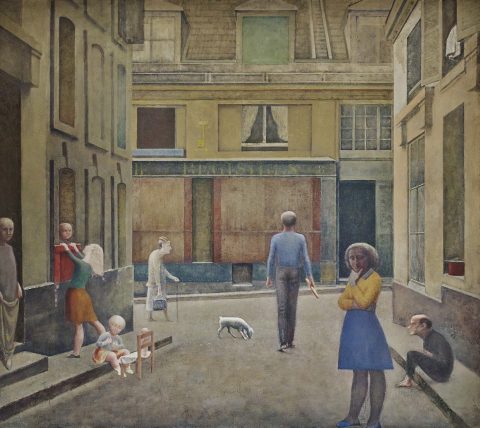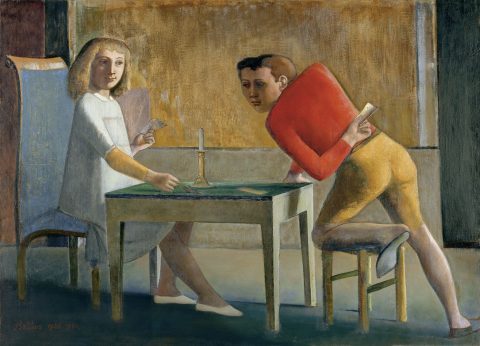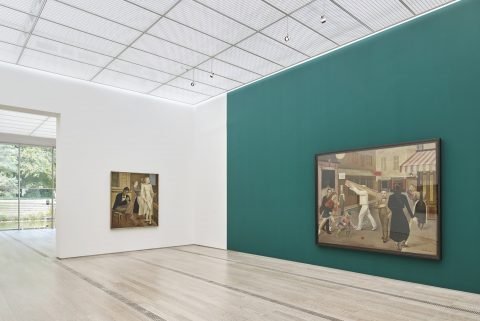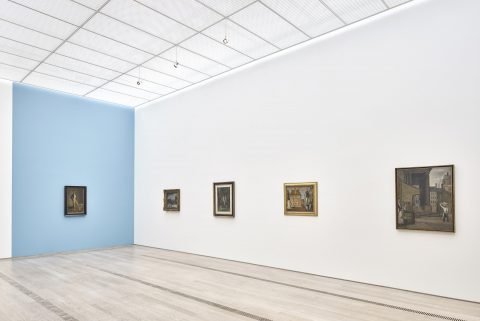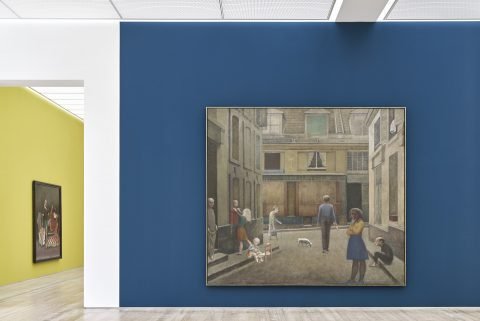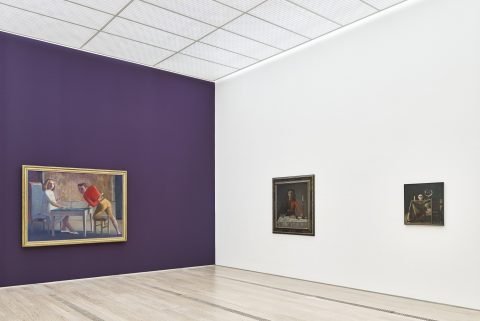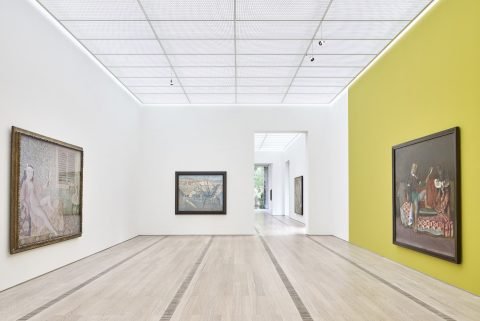Balthus: Beyeler honors Klossowski the younger
He loved castles, cats, the East and, above all, painting. That’s why he insisted art critics to write about his works, and not about him. But know the Beyeler thinks the time has come to go back to Balthus Klossowski.
- Balthus, Passage du commerce-saint-andré, 1952–1954. Oil on canvas, 294 x 330 cm, Private Collection © Balthus. Photo: Mark Niedermann
- Balthus, Children, 1937. Oil on canvas. Courtesy of Musée Picasso, Paris, France.
- Balthus, La partie de cartes, 1948 – 1950. Oil on canvas, 139.7 x 193.7 cm. Museo Nacional Thyssen-Bornemisza, Madrid © Balthus
- Installation view: Balthus. Courtesy of Fondation Beyler.
- Installation view: Balthus. Courtesy of Fondation Beyler.
- Installation view: Balthus. Courtesy of Fondation Beyler.
- Installation view: Balthus. Courtesy of Fondation Beyler.
- Installation view: Balthus. Courtesy of Fondation Beyler.
- Installation view: Balthus. Courtesy of Fondation Beyler.
He had a lifelong fondness for castles, which he considered both a goal and a shelter. His totem animals were cats. He could not resist the charm of the Orient.
Born Balthasar Klossowski in 1908, Balthus was a French painter who, in the history of art, stands in a class of his own. The antimodernist cat lover was nevertheless loved by modernists like Picasso – who bought his painting Les enfants Blanchard (1937) – and Giacometti.
Today, 17 years after his death, major works from different eras of his journey are gathered at the Fondation Beyeler in Weil am Rhein for Balthus’ first extensive monographic exhibition in German-speaking Switzerland – curated by Raphaël Bouvier and Michiko Kono – which will move to Thyssen-Bornemisza museum next year.
In 1968, at 60 years old and with his fame in full bloom, his retrospective exhibition was installed at the Tate Gallery, and for the catalogue Klossowski instructed art critic John Russell to state: “Balthus is a painter of whom nothing is known”. It has been a recurrent anecdote ever since, and rather a curious one, considering how the very blend of art and life is quintessential to Balthus’ mythology. On top of that, although he was reticent to release biographical information, he took great delight in cultivating his legend, which he infused with apocryphal details. For example: although he was of minor nobility, the title “Comte de Rola” was probably invented. In fact he was born on February 29th, and so his birthday occurred only in leap years. This might be a good excuse for his eccentricity; it is certainly the reason for his peculiar relationship with time.
He came from a Polish family that moved to Germany and later Paris, a clan whose friends included many artists and writers, the so called ‘intellectual aristocracy’. Among them was Rainer Maria Rilke, who managed to have twelve-year-old Balthus’ drawings published: a series dedicated to Mitsou, a cat that he found and then lost again.
“When I was young, I always felt like a little prince” Balthus used to say. At the age of 30, after a marriage with Antoinette de Watteville, two sons and an exceptionally bad debut – his first exhibition in Paris made a scandal and didn’t sell much – the painter moved into a chateau in Chassy, Burgundy, that he rented from a peasant. If ever grandeur inhabited there, by that point it had vanished. The building was unheated and unfurnished, and the ceiling leaked. But, on the other hand, it offered rooms full of light and space for his imagination. And there, between 1953 and 1960, he finished the monumental Passage du Commerce Saint-André (1952-54) and produced several memorable works. In 1961, André Malraux, French minister of culture, appointed him director of the Académie de France in Rome, housed at the Villa Medici, where Balthus lived until 1977. During that period, he dedicated much effort to the renovation of the splendid, dilapidated palazzo. While restyling the building he simultaneously restyled his art and himself too. On the walls, he tried to create a patina of antiquity by emulating the matte appearance of Renaissance frescos, which was eventually reflected in his canvases too. He also managed to bring home, from a cultural trip to Kyoto, a much younger Japanese wife, Setsuko Ideta. The woman is featured in one of the key works of Balthus’ Roman years, La Chambre turque (1965-66), a piece strongly reminiscent of the exoticism and detailed ornaments of Henri Matisse. He was often seen wearing a kimono. He moved for the last years of his life to Rossinière, near Gstaad, in Switzerland’s largest chalet, with its 113 windows, accompanied by his second wife and their daughter Harumi.
It goes without saying that Balthus had a lifelong fondness for everything aloof. The rest is not quite so straightforward. His most iconic motif – pubescent girls in bourgeois interiors – is more than anything else a sign of this detachment, a reverie suspended in time and consumed through the slow process of painting. His cult of childhood, that many critics point to, is probably a form of refusal. Balthus’ young girls, as writer James Lord put it, “dwell forever in a realm secure from the rude intrusion of common mortals”. Emerging from the dusky colours of the background, their unripe bodies vibrate with such an eroticism that many consider it improper.
As a result of that, in Basel they advise caution, reminding us of the commotion caused by one of Balthus’ masterpieces, Thérèse rêvant (1938), at the Metropolitan in New York. The museum was petitioned last year – at the height of the “MeToo” movement – to remove, or recontextualize the painting. For the record, in 2014 an exhibition of Balthus Polaroids – which he used as preparatory studies – was cancelled two months before the opening to avoid controversy.
Given this scenario, it is somehow amusing to read now what was written by Nicholas Fox Weber in his biography dedicated to the French artist. “I told Balthus of the remark of one New York collector, that her Balthus canvas shows a woman having an orgasm”. The painter denied roaring that sex was ever among his intentions. “But how typical that a rich American would get his art all wrong, he said, laughing. Balthus could hardly wait to have me tell the tale to each of the many visitors who came to Le Grand Chalet. It amused him both because it reflects the typical misinterpretation of paintings and because it suggested to him ‘that on Park Avenue women laugh when they are coming’ ”.
What really bothered Balthus was speculation, and all the more so because he believed that in front of a painting one should stop at the painting. The occasion today of an exhibition of his pictures displayed together at the Fondation Beyeler reveals that the common thread, rather than eroticism – which he made oblique – is the classicism revisited through his works. He refers back to Piero della Francesca, Masaccio and Nicolas Poussin. He used to study these masters as an essential grammar, and assimilated them in order to master his “craftsmanship”. And he went on inventing his idiosyncratic aesthetic universe, one that his very defiance of prevailing trends has rendered it timeless.
However, Balthus’ paintings took years to complete, as he was always seeking perfection. “You see, our time has won space, but does it know how to take its time?” asks in 1993 Balthus, in an interview for Le Figaro. “When you paint it’s not a matter of speed or progress. There is no progress in art. Are the drawings in the caves in Lascaux démodé compared to Piero della Francesca? Is Raphael transcended by Cézanne? Progress is when Louis XIV, in the XVII century, wants to have a bath in Versailles: you need 47 people to put together a bathtub, hot water, soap and a monarch. Today, you just turn on the tap!”
Were he still alive today, Balthus probably wouldn’t leave his castle, his shelter. All clad in dandy clothes, he fashioned himself in one of his rare self-portraits as the King of cats – Le Roi des chats is a painting from 1935 –, ready as he was for a time much more formal than his own. He complained in his later interviews about the loss of moral values and chivalry, and took refuge in a world made to measure, where he tried to resist the supreme sloppiness of his time. “Of all the legendary classic painters of the XX century,” writes German director Wim Wenders in the catalogue of his current exhibition, “only one lived to see the XXI century”. And that one is Balthus.
November 25, 2020

